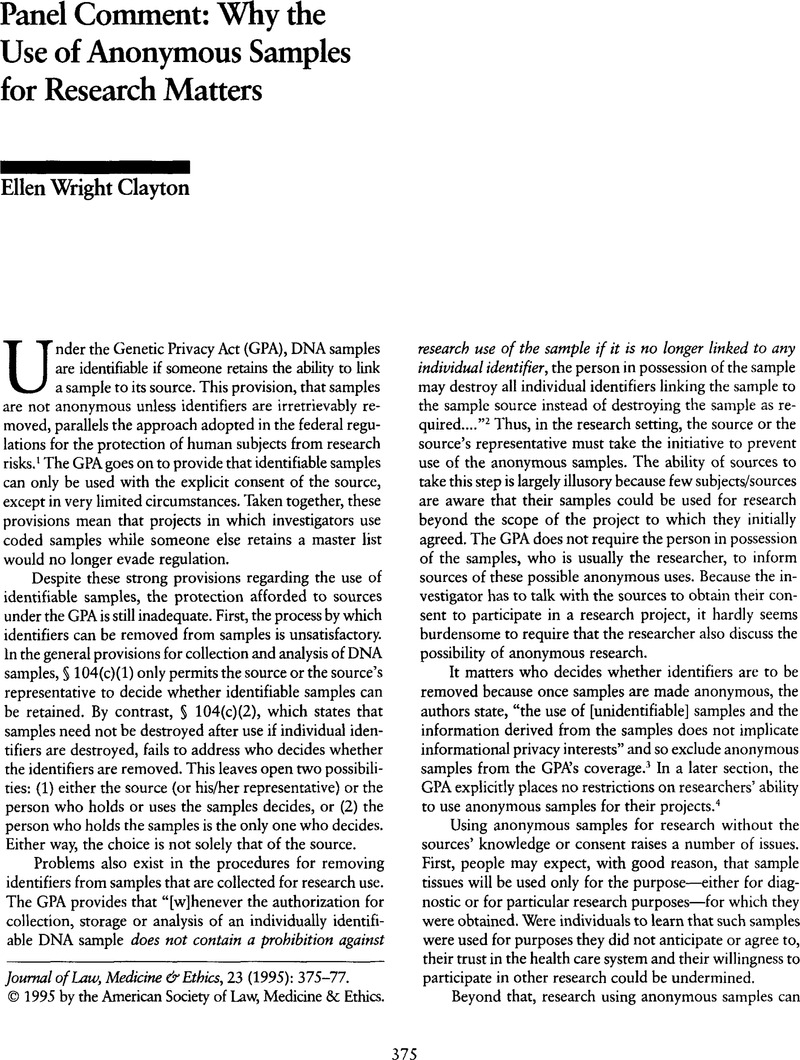Crossref Citations
This article has been cited by the following publications. This list is generated based on data provided by Crossref.
Foster, Morris W.
Eisenbraun, Ann J.
and
Carter, Thomas H.
1997.
Communal discourse as a supplement to informed consent for genetic research.
Nature Genetics,
Vol. 17,
Issue. 3,
p.
277.
Grizzle, William
Grody, Wayne W.
Noll, Walter W.
Sobel, Mark E.
Stass, Sanford A.
Trainer, Thomas
Travers, Henry
and
Weedn, Victor
1999.
Recommended Policies for Uses of Human Tissue in Research, Education, and Quality Control.
Archives of Pathology & Laboratory Medicine,
Vol. 123,
Issue. 4,
p.
296.
Roberts, Laura Weiss
Nolte, Kurt B.
Warner, Teddy D.
McCarty, Teresita
Rosenbaum, Lizabeth Stolz
and
Zumwalt, Ross
2000.
Perceptions of the Ethical Acceptability of Using Medical Examiner Autopsies for Research and Education.
Archives of Pathology & Laboratory Medicine,
Vol. 124,
Issue. 10,
p.
1485.
Naser, Curtis
and
Alpert, Sheri
2000.
Encyclopedia of Ethical, Legal and Policy Issues in Biotechnology.
Schwartz, Marc D.
Rothenberg, Karen
Joseph, Linda
Benkendorf, Judith
and
Lerman, Caryn
2001.
Consent to the use of stored DNA for genetics research: A survey of attitudes in the Jewish population.
American Journal of Medical Genetics,
Vol. 98,
Issue. 4,
p.
336.
Everett, Margaret
2004.
Can You Keep a (Genetic) Secret? The Genetic Privacy Movement.
Journal of Genetic Counseling,
Vol. 13,
Issue. 4,
p.
273.
Eriksson, Stefan
and
Helgesson, Gert
2005.
Potential harms, anonymization, and the right to withdraw consent to biobank research.
European Journal of Human Genetics,
Vol. 13,
Issue. 9,
p.
1071.
2006.
Reply to Human tissue bank regulations.
Nature Biotechnology,
Vol. 24,
Issue. 5,
p.
497.
Roy Choudhury, Shormila
and
Knapp, Leslie A
2006.
A review of international and UK-based ethical guidelines for researchers conducting nontherapeutic genetic studies in developing countries.
European Journal of Human Genetics,
Vol. 14,
Issue. 1,
p.
9.
Bergmann, Manuela M.
Görman, Ulf
and
Mathers, John C
2008.
Bioethical Considerations for Human Nutrigenomics.
Annual Review of Nutrition,
Vol. 28,
Issue. 1,
p.
447.
Peekhaus, Wilhelm
2008.
Research in the Biotech Age: Can Informational Privacy Compete?.
Bulletin of Science, Technology & Society,
Vol. 28,
Issue. 1,
p.
48.
Valle-Mansilla, J. Ignacio
Ruiz-Canela, Miguel
and
Sulmasy, Daniel P.
2010.
Patients’ Attitudes to Informed Consent for Genomic Research With Donated Samples.
Cancer Investigation,
Vol. 28,
Issue. 7,
p.
726.
Lee, Sandra Soo-Jin
2014.
Theories of Race and Ethnicity.
p.
26.
Gupta, Indranath
2024.
Expectations vs Realities of Information Privacy and Data Protection Measures.
p.
397.



